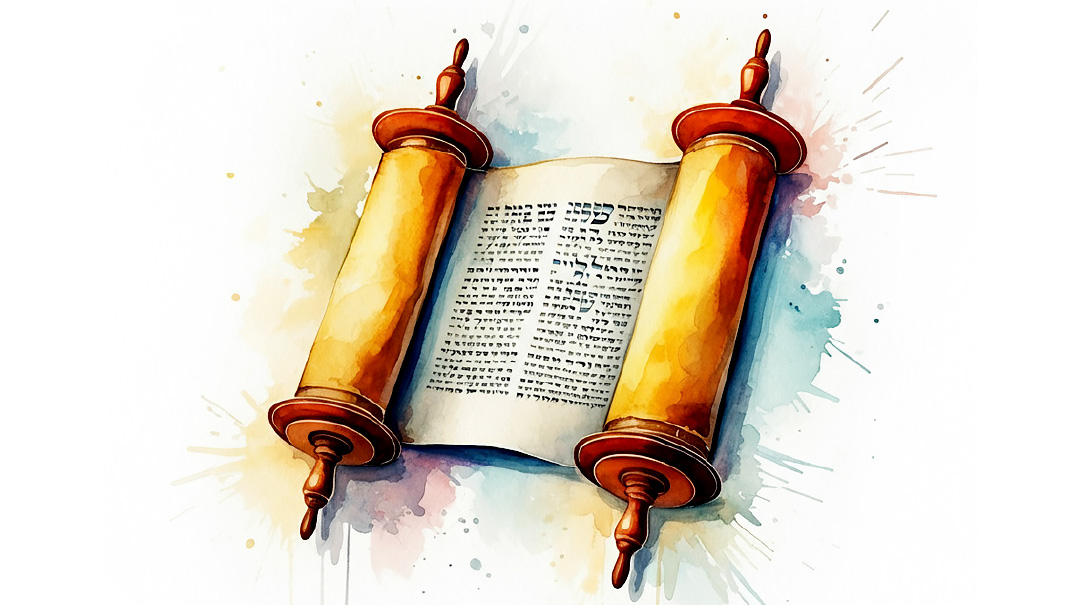A Time for Tears

Perhaps, this is why, as we conclude the final eight verses of the Torah, we dance exuberantly

And Moshe, the servant of Hashem, died there, in the land of Moav, by the mouth of Hashem. (Devarim 34:5)
T
he Gemara (Bava Basra 15a) asks a fascinating question: Our tradition maintains that Moshe wrote the Torah. Yet how can a living Moshe write the words “and Moshe died?” These final eight verses, which we read on Simchas Torah, describe his death and burial!
Rabi Yehudah or Rabi Nechemya say that the last eight verses, written after Moshe’s death, were written by his successor, Yehoshua.
Rabi Shimon disagrees, maintaining that the entire Torah was written by Moshe. However, he adds that up until this point, Hashem dictated and Moshe repeated each word and wrote it down. But for the final eight pesukim, Hashem dictated and Moshe wrote with tears.
It’s a haunting interpretation: Ever the teacher and ever the leader, Moshe performed one last heartbreaking mission before his death: He recorded his own end.
Still, how does Rabi Shimon answer the original question — if Moshe was alive, how could he write the untrue words “and Moshe died?”
One of the most moving interpretations comes from the Yad Rameh, the Ritva, and the Maharsha, who explain that the Gemara doesn’t mean that Moshe wrote these verses while he was crying; it means that he wrote them with actual tears, instead of ink.
The entire Torah was written with ink on parchment, but the final eight verses that tell the story of Moshe’s passing were transcribed not with ink, but with Moshe’s tears.
Says the Maharsha, this sort of writing, with tears, isn’t permanent. Its more ethereal nature allowed it to be written even before his actual passing. Moshe’s tears functioned as a kind of “invisible ink.” They made an imprint on the Torah, but they’d need to be reinforced with actual ink afterward. This explanation reconciles the two answers in the Gemara: Moshe wrote the verses in tears, and after his death, Yehoshua filled in the tears with ink (Rabbi YY Jacobson, TheYeshiva.net).
It was a half a year already, in a world gone crazy. A world which now included gloves, masks, tests, and tears. A world of loneliness, in which we each were locked into our own homes and a world of mourning; everyone knew someone who had felt searing loss.
Still, the Yamim Noraim were approaching, and while Pesach had been spent in total confusion, as we scrambled to acclimate ourselves to this new normal while still celebrating Yom Tov, by now we were unfortunately pros.
Our shul divided itself into many minyanim, one of which was right across the street from my home, and I listened to the tefillos from my garden. Please Hashem! Write us and seal us in the Book of Life!
Why did Moshe weep when he wrote those final verses? Were they tears of gratitude or of longing? Regret or joy? Was it the feeling of impotence in the face of frightful mortality? Or maybe it was the pain he felt saying goodbye to his beloved people?
Perhaps it was all of this, coupled with the overwhelming feeling of the magnitude of the moment. He had lived for 120 years; now his soul was about to depart. How do you put that into words? Tears capture the depth of such moments far more than any words can.
Is this not true for each of our lives? The Baal Shem Tov said that the Jewish people is a living sefer Torah, and every Jew is one of its letters. Each of us adds another chapter to the sacred scroll of Jewish history. Some of our chapters are written in ink; but others are written with tears. There are chapters in everyone’s lives that are written with tears — tears of sorrow, of gladness, tears of awe or gratitude, tears of ecstasy, and tears of facing the ultimate mystery of life.
Then the intensity of Rosh Hashanah and Yom Kippur gave way to the joy of Succos. As no one knew if travel or even eating together would be allowed, we built several succahs in our yard for our marrieds to use. While hoping for the best, we no longer took for granted the huge zechus and opportunity to spend Yom Tov meals together.
Toward the end of Chol Hamoed my son-in-law approached me. He said that several of our neighbors were trying to organize an outdoor minyan for hakafos — just a few families upstairs in our open k’nissah. Would our family be willing to host the sefer Torah?
We gathered the children and explained the zechus and the honor, as well as the many halachos involved when you have a sefer Torah under your own roof. Erev Yom Tov, my son-in-law gently carried the Torah into our home. It was a Sephardi sefer Torah, round and adorned with beautiful cloths, scarves, and silver, and the kids’ eyes grew round as he deposited it gently in my husband’s study, alongside the seforim.
The whole day, my kids whispered, played nicely, and helped for Yom Tov, cognizant of the added level of kedushah that now permeated our home.
On Shemini Atzeres we say Yizkor. How do you describe your bond with your mother? Your father? Your grandparents? Your siblings? Your aunts and uncles? Your best friends? Or, Heaven forbid, your departed child? How do you describe the void their death imprinted in your heart and the longing? How do you recall their final moments here on earth?
Moshe taught us — and this was the last lecture he imparted to his people — that some verses in our lives must be written not with ink, but with tears. They may be the only language to capture the magnitude, enormity, and mystery of the experience. At such moments, we don’t need explanations or solutions, just to be able to cry and know that Someone Who cares is listening.
What would it be like to capture those moments in our lives, the ones that bring us to tears, not as something to be hidden away or avoided, but as luminous connections with the undercurrent of spirit that enlivens all things? What scripture might we write if we allowed ourselves access to the invisible ink of our cracked-open hearts?
Perhaps, this is why, as we conclude the final eight verses of the Torah, we dance exuberantly. Moshe taught us how to cry with Hashem and with ourselves. And when we know how to cry, and that the Creator and the universe are not deaf to our tears, we also know how to dance.
Moshe remains a teacher until the very end, showing us the power of tears, and the dynamic nature of the text of Torah and the text of life. From this ending that is not an ending, we may now return to the beginning of the Torah to start all over again.
Shemini Atzeres and Simchas Torah are celebrated as one day here in Eretz Yisrael. After I bentshed licht, we walked up the stairs and lined up against the building wall as the men davened Maariv. And then my son-in-law came upstairs, carrying the sefer Torah with utmost care, and handed it straight to my husband for the honor of the first hakafah.
We sang, we danced, with spirit. Perhaps we didn’t hold hands, but we held each other’s hearts. There may have been social distancing, but there was no distance between our souls, each uplifted in joy for this opportunity to serve Hashem and dance with His Torah. There was still sickness, there was still so much unknown. But there was a time to worry and a time to dance. Next hakafah!
Abie Rotenberg’s lyrics crossed my mind, and I paraphrased them as I sang softly in my head:
We danced round and round in circles as if the world had not gone wrong
From evening until morning, filling up our hearts with song.
But we had the sefer Torah to clutch and hold so high,
As we begged Hashem for mercy, May Am Yisrael chai!
(Originally featured in Family First, Issue 862)
Oops! We could not locate your form.


